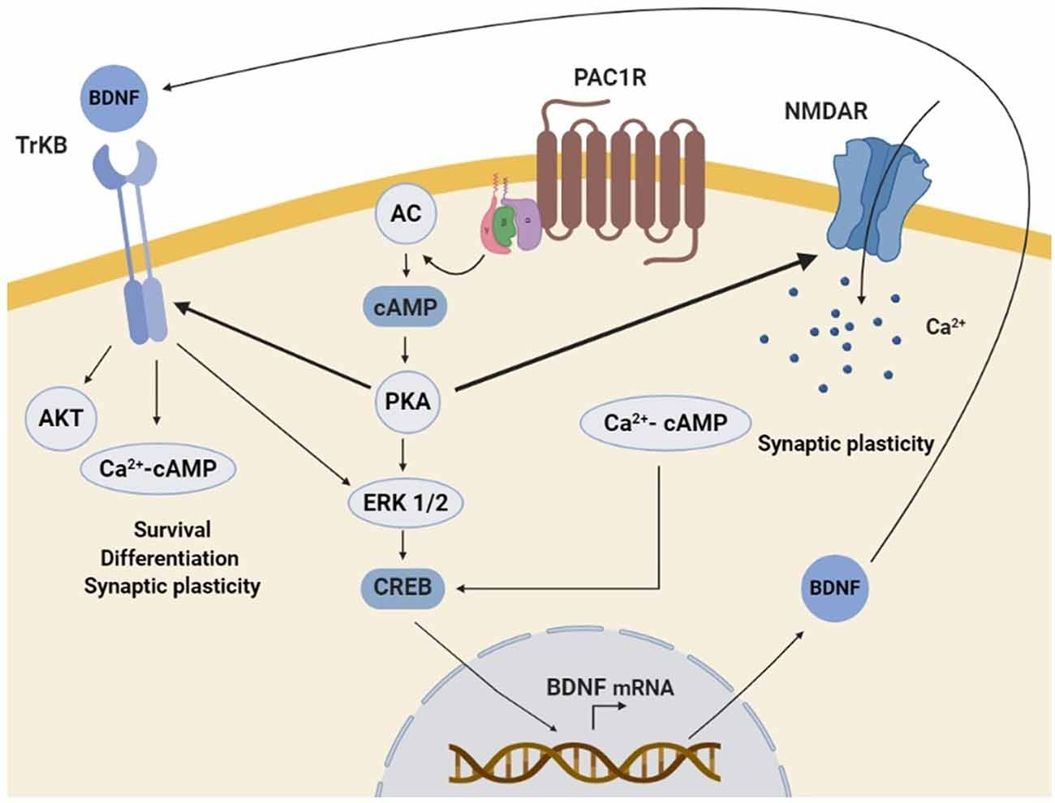Hi-Affi™ PAC1R Stable Cell Line
G protein-coupled receptors (GPCRs) are an important family of cell surface receptors that participate in diverse key physiological functions, e.g. detecting extracellular stimuli, facilitating intercellular communication, regulating cellular homeostasis. As such, GPCRs manifest as highly relevant drug discovery targets of over 40% currently marketed drugs, as well as numerous candidates under development. With years of exploration and experience in this area, Creative Biolabs has developed a world-leading Hi-Affi™ GPCR stable cell line platform for in vitro function studies against various GPCRs. In particular, we now are happy to present our well-validated Hi-Affi™ PAC1R stable cell line to our global clients.
Introduction to PAC1R
Pituitary adenylate cyclase-activating polypeptide (PACAP) is a 38-amino acid peptide that belongs to the vasoactive intestinal polypeptide (VIP)-glucagon-growth hormone releasing factor-secretin superfamily. PACAP is widely distributed in the brain and peripheral organs, especially in the gonads, endocrine pancreas, respiratory and urogenital tracts. The sequence of PACAP has been remarkably well conserved during the evolution from protochordate to mammals, suggesting that PACAP is involved in the regulation of important biological functions on the basis of its ability to stimulate cAMP formation in anterior pituitary cells.
 Fig.1 Schematic representation of the molecular mechanisms involved in PAC1R-mediated neurotrophic effect.1, 2
Fig.1 Schematic representation of the molecular mechanisms involved in PAC1R-mediated neurotrophic effect.1, 2
PACAP receptors have been identified in different tissues and the effects of PACAP are mediated through three types of GPCR. One type is the specific PACAP receptor (PAC1-R, previously called the type I PACAP receptor or PVR1), which binds PACAP38 and PACAP27 with a high affinity, but binds VIP with a 1000-fold lower affinity. The two other types of receptors are the VPAC1-R, which was previously called type II PACAP receptor or PVR2-R or VIP1-R, as well as the VIP-R, and the VPAC2-R, which was previously called type III PACAP receptor or PVR3-R or VIP2-R.
Hi-Affi™ PAC1R Stable Cell Line
Hi-Affi™ PAC1R stable cell line is developed by co-transfection of human PAC1R and cAMP-activated, membrane-associated fluorescent biosensor in U2OS cells. When PAC1R interacts with agonist/antagonist, changes in cAMP concentration will cause immediate translocation of biosensors (from plasma membrane to cytosol). Therefore, PAC1R activities will be translated into cellular fluorescence signals, which can be easily real-time monitored and quantified in living cells. Hi-Affi™ PAC1R cell line has been validated using an approved small molecular as PAC1R agonist in High Content Analysis (HCA) platform and revealed high efficiency, sensitivity, and reliability. It has been applied for assaying compounds and profiling PAC1R-modulating functions in early stage.
Featured Advantages of Hi-Affi™ PAC1R Stable Cell Lines
- Time- and cost-saving
- Easy to operate, with no special requirements for reagents or equipment
- Suitable for high-throughput screenings
- No modifications/labeling of PAC1R or downstream pathway components, allowing fully native signaling events
Except for PAC1R, Creative Biolabs now offers a full range of Hi-Affi™ GPCR stable cell lines with cAMP-activated biosensors, including but not limited to:
|
|
Meanwhile, based on different GPCRs and different signaling pathways, we also provide well-established Hi-Affi™ biosensor cell line options to assess calcium-, DAG-related as well as multiplex pathway events of various GPCRs. If you cannot find your desired target in the catalog, we are always happy to establish a specific strain upon request. Please contact us for more information.
References
- Solés-Tarrés, Irene, et al. "Protective effects of pituitary adenylate cyclase-activating polypeptide and vasoactive intestinal peptide against cognitive decline in neurodegenerative diseases." Frontiers in Cellular Neuroscience 14 (2020): 221.
- under Open Access License CC BY 4.0, without modification.
For Research Use Only.
